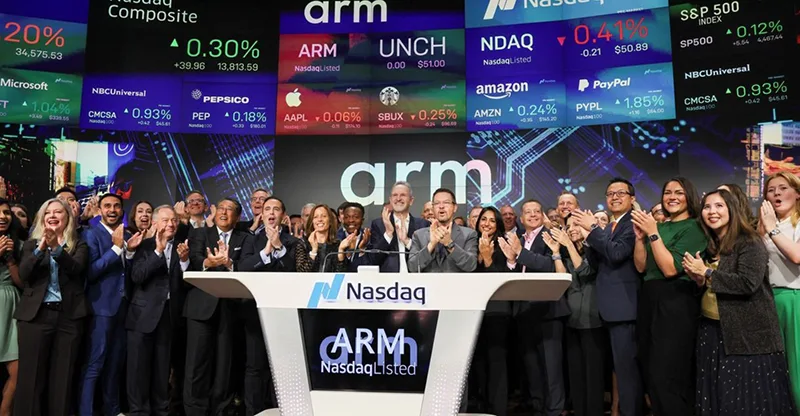In a debut performance that left spectators in awe, an athlete achieved an unprecedented feat by propelling their arm to heights previously thought unattainable. This remarkable achievement has not only captivated the hearts of sports enthusiasts but has also shattered preconceived notions of what is achievable in the world of athletics.
The athlete’s incredible arm performance has set a new standard for excellence and sparked widespread curiosity about their extraordinary skills. In this comprehensive introduction, we will delve into the intricate details of this remarkable inaugural performance. We will explore the athlete’s background, delve into the circumstances surrounding the event, and uncover the unwavering determination that propelled their arm to soar to remarkable heights.

Arm Holdings PLC, a prominent player in the technology sector, made its highly anticipated debut on the Nasdaq stock exchange in the United States, marking a significant milestone. The company’s American depositary receipts (ADRs) under the symbol ARM witnessed a meteoric rise on their first trading day, surging an astonishing 25% above their initial offering price.
SoftBank’s Arm soars nearly 25% in market debut to $65 billion valuation https://t.co/99aOelXUui pic.twitter.com/DW5ESWC3nW
— Reuters Tech News (@ReutersTech) September 14, 2023
The trading day commenced with Arm’s ADRs opening at $56.10, surpassing their initial public offering price of $51. As the trading day unfolded, these shares reached a peak, soaring as high as 30% above their IPO price. By day’s end, the ADRs had settled at $63.59, reflecting a remarkable 24.7% gain. With a total of 1.03 billion shares in circulation, this surge in value propelled Arm to attain a market capitalization exceeding $65 billion.
The decision to price the shares at the upper end of the expected range the day before the IPO laid the groundwork for this impressive performance. However, what followed after the market closed was equally noteworthy, as the ADRs experienced a further increase of over 5%.
Jason Child, Arm’s Chief Financial Officer, shared insights into the company’s future trajectory. He emphasized the company’s primary objective of capitalizing on the rising costs associated with producing increasingly miniature transistors for chips, measured in nanometers. Child noted that as transistors have decreased in size, the expenses related to intellectual property and software testing have escalated to the point where they constitute up to three-quarters of the design cost.
In response to this evolving landscape, chip manufacturers have begun outsourcing these costs to Arm rather than shouldering them internally. By providing IP and software verification services, Arm offers a cost-effective alternative. Child explained, “It lets us do the work and then make money off of it.” This approach allows Arm to secure higher royalty rates over time, as more companies opt for their services rather than undertaking these tasks independently.
Furthermore, Child highlighted that this shift has led to an increasing number of clients seeking Arm’s expertise in creating comprehensive computer subsystems, going beyond the realm of central processing unit instruction sets. He stated, “As a result, more customers are taking us up on that offer because it saves them a lot of time and a lot of money.”
Arm’s IPO garnered significant attention, with reports of multiple oversubscriptions. However, concerns about potential global tensions arising from U.S.-China trade conflicts loomed in the background.
Child addressed some of these concerns, noting that the language outlining the company’s risks often stemmed from legal considerations focused on worst-case scenarios. Arm’s filing specified that its China business operates independently, presenting “significant risks.” Despite this, Child expressed optimism, stating, “That being said, it’s China,” and noting that his experience with China had been remarkably smooth compared to his tenure with other global companies.
Arm’s CFO shared the company’s intention to release its first earnings report in November, covering the quarter ending on September 30. Additionally, he mentioned plans to report results jointly with SoftBank, which holds a 90% stake in Arm.
The fiscal year ending on March 31, 2023, saw Arm allocating 41% of its revenue to research and development (R&D), reflecting a continuous increase from 37% in 2022 and 40% in 2021. Arm anticipates R&D expenses to rise by 13.9% to $1.13 billion in 2023, while sales are projected to experience a marginal decrease of less than 1%, reaching $2.68 billion.
Notable cornerstone investors, including Nvidia, AMD, Apple Inc., and Alphabet Inc., played a pivotal role in Arm’s journey to IPO success. Google, in particular, invested approximately $735 million in American depositary shares at the same price as other buyers.
The origins of Arm’s IPO can be traced back to when Nvidia’s CEO, Jensen Huang, abandoned his $40 billion bid to acquire Arm from SoftBank Group Corp. in February 2022. Regulatory opposition, including the Federal Trade Commission (FTC), contributed to the deal’s dissolution. Subsequently, SoftBank announced its intention to list Arm on the stock market by March 31, 2024. Notably, SoftBank had acquired Arm for $32 billion in 2016.
This debut performance in the stock market represents a significant milestone for Arm and underscores the company’s potential in the technology sector. As Arm’s journey continues, it will be fascinating to observe how this technological powerhouse shapes the future of innovation and global markets.





